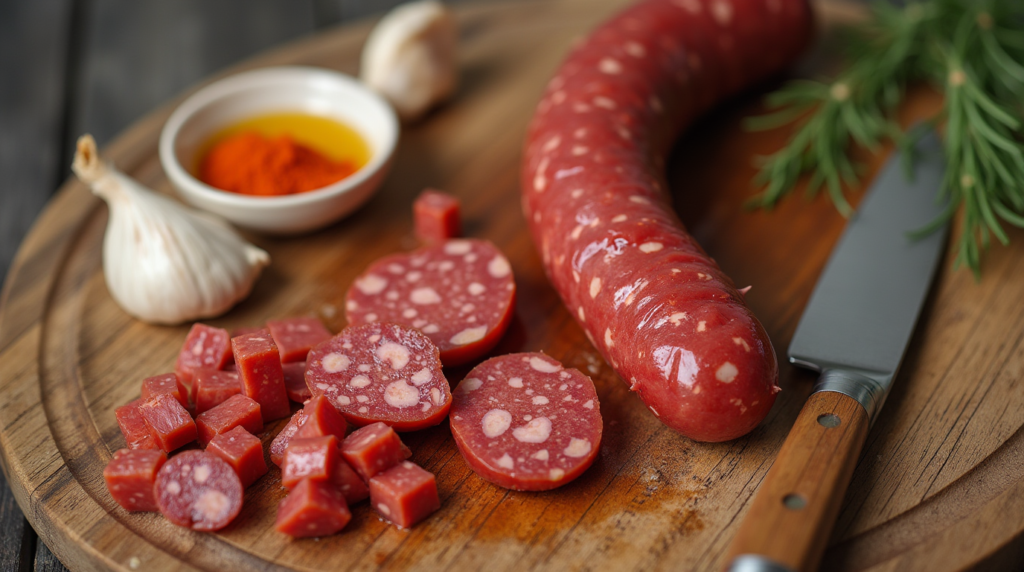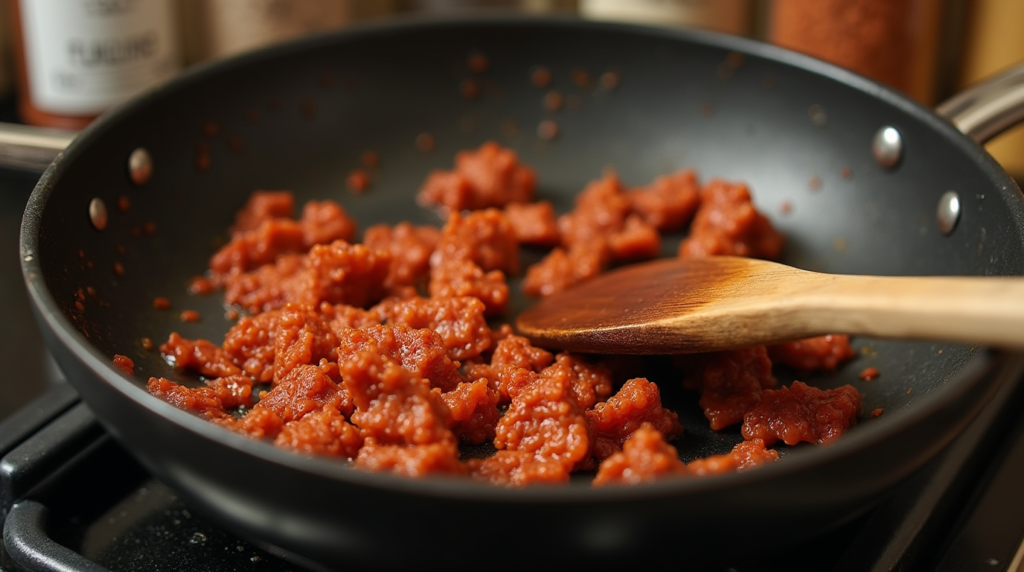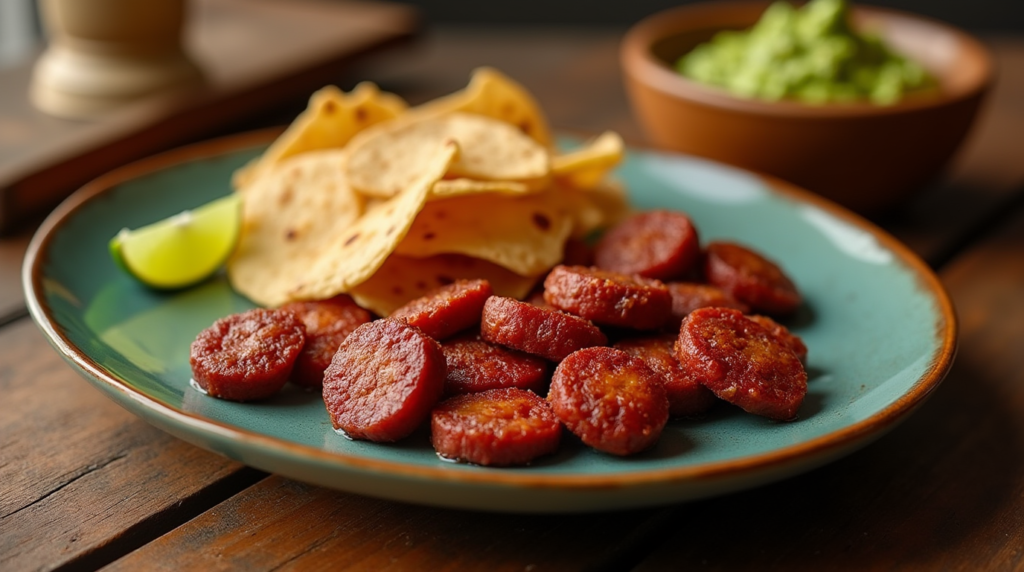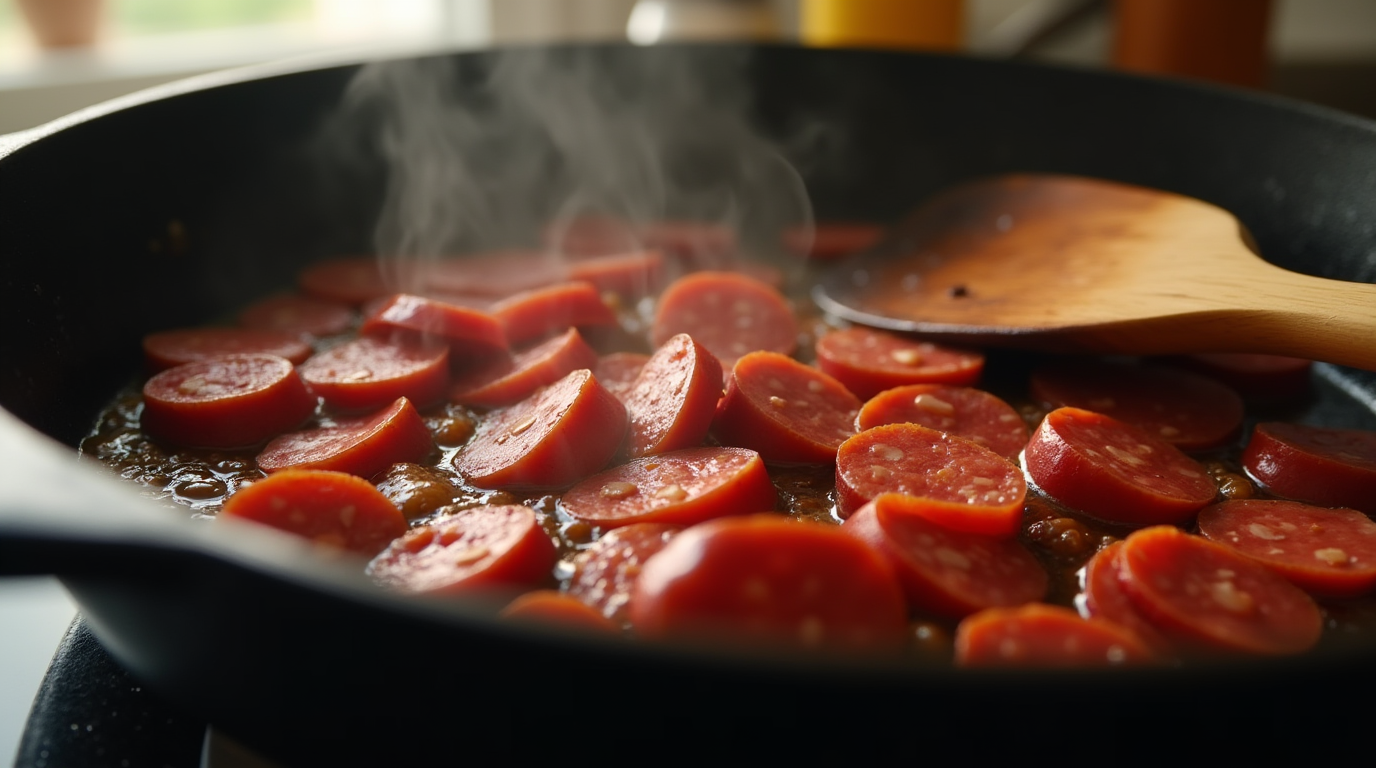Chorizo is a flavorful sausage that delivers a burst of spice to many dishes. Yet, home cooks often wonder, How long does it take to fry chorizo? Finding the right frying chorizo duration makes the difference between rubbery meat and a richly seared masterpiece. For an innovative twist, consider pairing your chorizo with fried bread in an air fryer—a healthier, crunchier alternative.
Timely cooking allows the sausage’s paprika, chili, and garlic flavors to bloom, resulting in a perfectly fried chorizo that pairs well with rice, eggs, or even roasted vegetables. If you are still looking for the best chorizo frying guide, focusing on consistent heat and proper timing provides a tasty outcome every time.
Understanding Chorizo
Chorizo has long captured the hearts of food lovers. Its robust taste comes from the combination of pork and bold spices, making it a go-to in Spanish and Latin American cuisine. Whether you are trying to figure out how to fry chorizo for tacos or want a new protein option for breakfast, learning about chorizo’s origins and types can elevate your cooking.
A good chorizo frying guide will emphasize that fresh chorizo and cured chorizo differ greatly in texture and cooking needs. Knowing which version you have plays a big part in determining the ideal frying chorizo duration for flavorful results.
Origin and Cultural Significance
Chorizo’s roots trace back to the Iberian Peninsula. Spanish explorers spread the sausage to Latin America, where local ingredients influenced new variations. Today, chorizo appears in everything from tapas to street tacos.
Each region interprets the sausage differently—some add vinegar and peppers, others rely on smoked paprika for depth. Because it is so deeply woven into many cultures, you will find a wide range of recipes emphasizing cooking chorizo time. Regardless of place, though, well-cooked chorizo remains a symbol of culinary heritage and communal gatherings.
Fresh vs. Cured Chorizo
Fresh chorizo requires a careful eye on how long does it take to fry chorizo? This variety has higher moisture content and is raw, so achieving safe doneness while preserving juicy texture is crucial. You might crumble or slice it based on the dish you have in mind. Cured chorizo, on the other hand, goes through a drying process that intensifies flavor and extends shelf life.
Semi-cured options cook faster due to reduced moisture, while fully cured sausages can be eaten with minimal or even no frying. In either case, focusing on frying chorizo duration helps ensure each piece is crispy but not dried out.
Key Ingredients in Chorizo
Paprika, garlic, and chili peppers form the backbone of chorizo’s punchy profile, though exact blends vary by region. Paprika contributes both color and warmth, while garlic provides an aromatic base. Chili peppers add heat and complexity, ranging from mild to fiery.
Many recipes also include herbs, salt, and sometimes wine or vinegar for acidity. These ingredients not only shape the taste but also influence how to fry chorizo properly. For instance, higher fat content from pork helps the sausage brown more quickly, dictating how you manage cooking chorizo time. By grasping these key components, you gain more control over achieving a perfectly fried chorizo and can adjust flavors to suit your preference.
Preparing Chorizo for Frying
Before you begin, a little prep work helps you master how to fry chorizo. Each step—thawing, slicing, and choosing the right oil—shapes your results and affects the frying chorizo duration.
Good preparation also prevents uneven cooking or soggy sausage. If you ever wonder, “How long does it take to fry chorizo?”, your advance setup plays a key role in speeding up the process and producing a perfectly fried chorizo.

Thawing Frozen Chorizo
Start by bringing frozen chorizo to a safe, workable temperature. Thawing it in the refrigerator is your best option. This slower method keeps flavor intact and prevents the growth of harmful bacteria.
If you must thaw quickly, use a sealed bag in cold water, changing the water every 30 minutes. Proper thawing shortens cooking chorizo time because the meat is closer to its ideal frying temperature. Skipping this step might leave you with raw spots in the middle or add extra minutes to the pan.
Slicing or Dicing: Best Practices
When preparing to fry, decide if you want slices or smaller chunks. Slices work well when layering chorizo in pasta or topping pizzas, while dicing suits tacos or breakfast scrambles.
Regardless of shape, ensure uniform thickness so each piece cooks evenly and you avoid varying frying chorizo duration. An even size also helps with crisping the edges. For a quicker cook, go thinner; for a juicier bite, keep slices a bit thicker.
Oil Selection for Frying Chorizo
Chorizo is often fatty, but adding a small amount of oil can help kickstart browning. High-smoke-point oils like canola or vegetable oil reduce the risk of burning.
Choose an oil that lets you maintain medium-high heat, since too high a temperature may scorch your sausage before the interior cooks through. Tailor your chorizo frying guide to suit the fat content of the chorizo you have on hand. That way, you’ll refine how long does it take to fry chorizo? and craft a quick, tasty meal without overcooking.
Frying Chorizo Step-by-Step
Cooking chorizo on the stove involves several key details that shape your results. If you have ever wondered how to fry chorizo, knowing when to start and how to handle the heat is critical.
A solid chorizo frying guide begins with the right equipment. Use a sturdy skillet or pan that can hold steady heat. This technique helps you manage both the cooking chorizo time and the overall frying chorizo duration, ensuring no raw spots remain. By following the steps below, you set yourself up for a perfectly fried chorizo with loads of flavor.

Preheating the Pan
A hot pan is your best friend when browning chorizo. Preheat your skillet on medium to medium-high heat for about two to three minutes. This step allows the surface to reach an even temperature. Once the pan is heated, add a small amount of oil if needed.
Remember, many chorizo sausages already contain fat, so too much oil might cause splattering. Allow the oil—or the sausage’s natural fat—to shimmer slightly before adding your chorizo pieces. If you drop them in too early, you risk a longer cooking chorizo time since the meat and pan will heat up together instead of letting the chorizo brown right away.
Ideal Cooking Temperature
Moderate heat ensures the interior cooks through without burning the exterior. If the temperature is too low, you may extend the frying chorizo duration unnecessarily. If it’s too high, you risk charring the outside while leaving the center undercooked. Find a balance that sizzles without scorching.
Keep an eye on color changes and reduce the heat if you notice excess browning in under a minute. With a bit of practice, you will learn how long does it take to fry chorizo? based on your stove’s heat settings.
Time Required for Fresh vs. Cured Chorizo
Fresh chorizo usually takes 8–10 minutes to cook through, although thickness and heat level can adjust that figure. Cook it until the interior is no longer pink and the exterior has a nice crisp. Cured or semi-cured varieties tend to cook faster, often in 5–7 minutes, since they have lower moisture.
The cooking times mentioned serve as a guide. The best indicator is an internal temperature of around 160°F (71°C) if you want total assurance of doneness. Knowing these figures helps you refine how to fry chorizo for any recipe.
Indicators of Doneness
Identifying when your chorizo is done allows you to serve it at peak flavor. While specific chorizo frying guide recommendations can offer an approximate timeframe, real-time cues often provide a clearer picture.
If you are curious how long does it take to fry chorizo?, the final signs of readiness come from color, sound, and aroma. These details confirm whether you have a perfectly fried chorizo or if you need a moment more in the pan.

Visual Cues: Color and Texture
Pay attention to changes in color, as well-browned chorizo tends to develop a deep reddish-brown hue. This shade indicates that the paprika and chili elements have caramelized.
A slightly crisp outer layer pairs well with a firm (but still moist) interior. Slice into one piece to check if there’s any sign of rawness. You can then determine if your cooking chorizo time needs a brief extension.
Sound and Sizzling Patterns
A gentle sizzle hints that your pan remains at the right temperature. If the sound fades too quickly, you might have turned the heat down too much, lengthening the frying chorizo duration. If it crackles too intensely, the pan may be too hot, risking burnt edges.
By listening carefully, you can adjust the flame or remove the pan from direct heat to fine-tune your cooking process.
Smell: Knowing When It’s Ready
Aromatic hints act as another form of signposting. When the garlic, paprika, and chili scents merge into a robust, savory aroma, you are likely close to having a perfectly fried chorizo.
The fragrance should be rich but not acrid or burnt. If you detect a sharp or overly smokey smell, quickly lower the heat. Balancing these cues—from color to scent—lets you expertly judge how long does it take to fry chorizo? for any style of chorizo you choose.
Common Mistakes and How to Avoid Them
Cooking chorizo can be tricky, even if you’ve followed a solid chorizo frying guide. Paying attention to frying chorizo duration and maintaining the right heat goes a long way in preventing some common mistakes.
Whether you’re new to the kitchen or a seasoned cook, a few key pitfalls stand out. Master them, and you’ll have a perfectly fried chorizo that packs flavor in every bite.
Overcooking and Dry Chorizo
Chorizo contains fat that melts during cooking, giving it a rich taste. However, extending the cooking chorizo time beyond what is needed often leads to dryness. The sausage can lose its succulent character and turn chewy.
To avoid this, keep an eye on color cues—deep reddish-brown usually signals it is close to done. If you wonder, “How long does it take to fry chorizo?”, use an internal temperature check (around 160°F or 71°C) or slice a piece to see if the interior is no longer pink.
Uneven Cooking
Searing chorizo in large chunks can lead to crispy edges but raw centers. If you’re learning how to fry chorizo for the first time, consider cutting it into uniform slices or small pieces.
This way, the interior cooks at the same pace as the exterior. Stir or flip them periodically so each surface makes contact with the pan, which keeps the frying chorizo duration more predictable and consistent.
Burning the Pan: Prevention Tips
A scorched pan introduces bitter flavors and can ruin your meal. Keep your heat at medium or medium-high, and add a splash of oil only if your chorizo lacks enough fat.
Avoid leaving the sausage unattended, and reduce the flame if you see excessive smoke. By doing so, you’ll maintain a safe, controlled environment and achieve that perfectly fried chorizo without scorching your skillet.
FAQs About How Long Does It Take To Fry Chorizo
What’s the Difference Between Spanish and Mexican Chorizo?
Spanish chorizo is typically cured or semi-cured, often smoked and ready to eat. Mexican chorizo is raw, with bold chili seasonings, and must be fully cooked.
How Do I Avoid Splattering Oil?
Keep the heat at medium, pat the sausage dry, and avoid overcrowding the pan. Using a splatter screen also helps.
Can I Fry Chorizo Without Oil?
Yes, if the chorizo is fatty enough, it releases its own oil when heated. Use a small splash only if the pan is too dry.
Conclusion
Achieving a perfectly fried chorizo hinges on balancing frying chorizo duration with the right heat. Understanding your chorizo type, prepping uniformly sized pieces, and listening for that ideal sizzle will improve your results.
By following a reliable chorizo frying guide and monitoring each detail, you’ll master how long does it take to fry chorizo? with ease.

